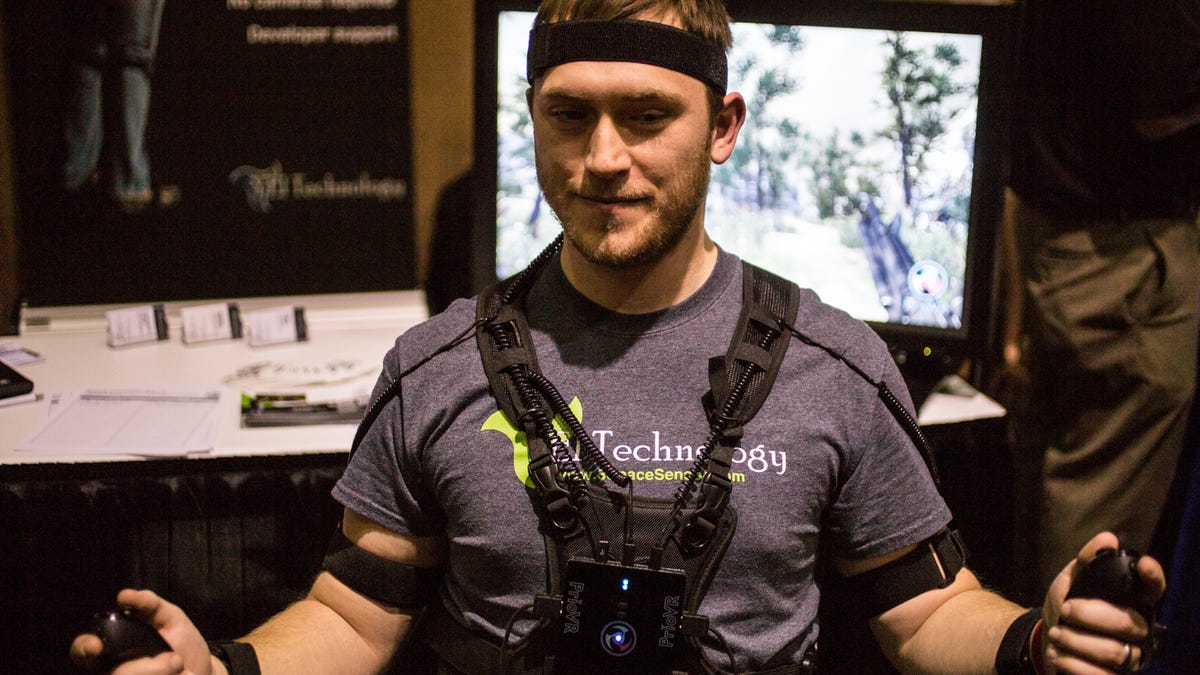Gaming exoskeleton to pair with Oculus Rift headset at CES 2014
PrioVR, the full-body tracking suit, rebounds from its failed Kickstarter with a fully-functional prototype at CES 2014 that will pair with the Oculus Rift headset.

LAS VEGAS -- The future of gaming, at least to those banking on the rise of virtual reality, lies not just with better graphics or voice control, but with sensor suits and headsets that bring our real-world movements to life onscreen. At CES 2014, the PrioVR full-body tracking suit is on display and the company behind it, YEI Technology, is partnering with VR headset maker Oculus Rift to showoff a fully immersive gaming experience later this week.
Sailing toward the far-off sci-fi future of those powered exoskeletons in "The Matrix" or the video game series Crysis, the PrioVR hardware is a string of strap-on sensors extensive enough to make anyone look like an actor in a motion capture studio. Its half-body system includes sensors for a user's head, elbows, and wrists that can be expanded into a full-body suit that tracks one's shoulder, waist and leg movements.
"That allows you to drop on the ground, roll around, shoot under your leg, curl up into a fetal position," said Paul Yost, YEI's chief of R&D. "We have this collection of inertial sensors that combines with a software that ties all that together into this skeletal model. All that happens on the system itself, so there's no computational load on the PC other than the communication."
Combined with that software are API plug-ins, Yost pointed out, that are compatible with all major gaming engines, allowing developers to drop the suit support into into any application with relative ease. PCs are the starting point, but YEI hopes to expand to consoles as well.
As far as movement goes, players wield a nunchuk-like controller similar to that of the original Wii to navigate the game environment and utilize both hands and his or her upper body to make more nuanced movements. On the floor at CES, a user strapped into the half-body PrioVR prototype played a first-person shooter demo, shifting in his chair to peek out of corners and furiously angling a virtual weapon with his hands.
While this iteration of the PrioVR is new, YEI's attempts to jump into the VR market trace back to last fall. PrioVR originally launched on Kickstarter last September, where it racked up an impressive $111,000 but failed to meet its $225,000 goal.
"That was fortunate for us," said Yost. "We learned from the gaming community, who are brutally honest, what they expected to see and what they wanted."
So on February 14, YEI will again launch a Kickstarter campaign, this time with a more impressive showing of its final product and a lower goal of less than $100,000. Ultimately, Yost said, the full-body version of the suit will sell for roughly $400, while the torso half of it will go for around $270.
Yost stressed that the system is modular, meaning those who buy the half-body PrioVR set can add more sensors and functionality, for sections like the waist and shoulders, onto their suit incrementally.
By August, Yost is confident that the PrioVR will be in mass production and that every Kickstarter backer will have their very own PrioVR suits. Its a bold goal, and its success hinges on the relationship YEI builds with VR superstars like Oculus Rift, which will include full-body suit demos at CES starting Tuesday.

